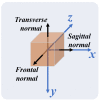Feasibility of 3D Body Tracking from Monocular 2D Video Feeds in Musculoskeletal Telerehabilitation
- PMID: 38203068
- PMCID: PMC10781343
- DOI: 10.3390/s24010206
Feasibility of 3D Body Tracking from Monocular 2D Video Feeds in Musculoskeletal Telerehabilitation
Abstract
Musculoskeletal conditions affect millions of people globally; however, conventional treatments pose challenges concerning price, accessibility, and convenience. Many telerehabilitation solutions offer an engaging alternative but rely on complex hardware for body tracking. This work explores the feasibility of a model for 3D Human Pose Estimation (HPE) from monocular 2D videos (MediaPipe Pose) in a physiotherapy context, by comparing its performance to ground truth measurements. MediaPipe Pose was investigated in eight exercises typically performed in musculoskeletal physiotherapy sessions, where the Range of Motion (ROM) of the human joints was the evaluated parameter. This model showed the best performance for shoulder abduction, shoulder press, elbow flexion, and squat exercises. Results have shown a MAPE ranging between 14.9% and 25.0%, Pearson's coefficient ranging between 0.963 and 0.996, and cosine similarity ranging between 0.987 and 0.999. Some exercises (e.g., seated knee extension and shoulder flexion) posed challenges due to unusual poses, occlusions, and depth ambiguities, possibly related to a lack of training data. This study demonstrates the potential of HPE from monocular 2D videos, as a markerless, affordable, and accessible solution for musculoskeletal telerehabilitation approaches. Future work should focus on exploring variations of the 3D HPE models trained on physiotherapy-related datasets, such as the Fit3D dataset, and post-preprocessing techniques to enhance the model's performance.
Keywords: 2D camera; 3D Human Pose Estimation; MediaPipe Pose; ROM; deep learning; monocular; musculoskeletal; telerehabilitation; videos.
Conflict of interest statement
The authors declare no conflicts of interest. The sponsors had no role in the design, execution, interpretation, or writing of the study.
Figures















References
-
- Cieza A., Causey K., Kamenov K., Hanson S.W., Chatterji S., Vos T. Global estimates of the need for rehabilitation based on the Global Burden of Disease study 2019: A systematic analysis for the Global Burden of Disease Study 2019. Lancet. 2020;396:2006–2017. doi: 10.1016/S0140-6736(20)32340-0. - DOI - PMC - PubMed
-
- Areias A.C., Costa F., Janela D., Molinos M., Moulder R.G., Lains J., Scheer J.K., Bento V., Yanamadala V., Correia F.D. Long-term clinical outcomes of a remote digital musculoskeletal program: An ad hoc analysis from a longitudinal study with a non-participant comparison group. Healthcare. 2022;10:2349. doi: 10.3390/healthcare10122349. - DOI - PMC - PubMed
-
- Dias G., Adrião M.L., Clemente P., da Silva H.P., Chambel G., Pinto J.F. Effectiveness of a Gamified and Home-Based Approach for Upper-limb Rehabilitation; Proceedings of the Annual International Conference of the IEEE Engineering in Medicine & Biology Society (EMBC); Scotland, UK. 11–15 July 2022; pp. 2602–2605. - PubMed
MeSH terms
Grants and funding
LinkOut - more resources
Full Text Sources

